Graceful, devoted, and standing tall (literally) in the wetlands of India, the Sarus Crane is a bird that commands respect and affection alike. Known for their elegant dance, lifelong pair bonding, and haunting calls, these birds are as poetic as they are powerful. Let’s journey into the life of this fascinating bird that has inspired everything from folklore to conservation efforts.
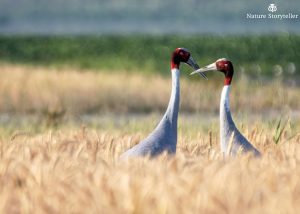
Quick Facts about Sarus Cranes
| Feature | Detail |
| Scientific Name | Antigone Antigone |
| Common Name | Sarus Crane |
| IUCN Status | Vulnerable |
| Habitat | Wetlands, marshes, agricultural fields |
| Range in India | Northern and central India – especially Uttar Pradesh, Bihar, Rajasthan, Madhya Pradesh |
| Height | Up to 5.9 feet (tallest flying bird!) |
| Wingspan | Around 8 feet |
| Diet | Omnivorous – includes aquatic plants, insects, seeds, small vertebrates |
What Do Sarus Cranes Look Like
One word: majestic!
Sarus Cranes are easily recognizable by their tall grey bodies, long pink legs, and a striking bare red head and upper neck. Their sheer height, often taller than a human child, makes them an unforgettable sight in the Indian countryside.
Both males and females look alike, though males tend to be slightly larger. In flight, their broad wings and stretched-out necks create an elegant silhouette — a ballet in the sky.
How to Identify a Sarus Crane
Sarus Cranes are large, elegant, and easy to recognize if you know what to look for:
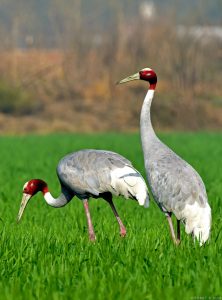
Key Identification Features:
- Height: Up to 5.9 feet tall – taller than most adult humans when standing upright!
- Color: Light grey plumage with a striking red head and neck (bare skin, not feathers)
- Beak: Long, dagger-shaped, and greyish
- Legs: Long and pinkish-red
- Call: Loud, trumpeting, and resonant – often heard from kilometers away
- Flight: Broad wings and graceful gliding, neck and legs fully extended
Tip for Beginners: Don’t confuse them with the Common Crane or Demoiselle Crane — both are smaller and lack the full red neck and the same stature.
Lifetime Bonding Among Sarus Cranes
One of the most touching facts about Sarus Cranes is their lifelong monogamous bond. Once a male and female pair up, they typically remain together for life — a rarity among birds.
- They mate, nest, forage, and migrate locally as a unit.
- Even when not breeding, pairs often engage in synchronized displays — calling in duet, dancing in unison, or gently preening each other.
- In cases where one partner dies, the surviving bird may mourn visibly, refusing food or avoiding other birds for days. While they may eventually take a new mate, it’s never immediate.
- In many Indian villages, locals believe that harming one Sarus Crane brings misfortune, due to their legendary love and fidelity.
The Courtship Dance of Sarus Cranes: A Love Story in the Marsh
Sarus Cranes are famously monogamous and mate for life — a rare trait in the bird world. Their courtship dance is nothing short of magical:
- They bow, leap, and twirl with synchronized steps.
- Their duet calls echo across wetlands.
- Even after pairing, they regularly perform these rituals to reaffirm their bond.
Locally, they’re seen as symbols of fidelity and eternal love — a romantic emblem in Indian folklore.
Sarus Cranes are most commonly spotted in north and central India, though their range can extend further based on season and habitat availability.
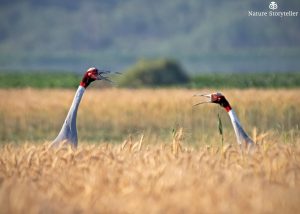
Top Places to Spot a Sarus Crane
- Etawah, Mainpuri, Aligarh (Uttar Pradesh) – Largest breeding population
- Keoladeo National Park, Rajasthan
- Sultanpur Bird Sanctuary, Haryana
- Khajuraho Region, Madhya Pradesh
- Mahi River Basin, Gujarat
- Chilika Wetland edges, Odisha
They prefer:
- Flooded agricultural fields (like rice and wheat)
- Shallow freshwater marshes and wetlands
- Seasonal swamps and grasslands
Tip: Visit early morning or late afternoon for best sightings — especially in the monsoon and post-monsoon seasons.
How is the Sarus Crane Different from Other Cranes
India is home to several crane species — but the Sarus Crane stands apart, both physically and behaviorally.
Unique Traits of Sarus Cranes:
| Feature | Sarus Crane | Other Cranes |
| Height | Up to 5.9 ft – tallest flying bird | Smaller (e.g., Common Crane: ~4 ft) |
| Coloration | Grey body, bare red head and neck | Typically grey with feathered heads |
| Pair Bonding | Lifetime pairs, highly expressive | Most species form seasonal pairs |
| Habitat Preference | Adapts to human agriculture, nests in flooded fields | Prefer remote marshes or protected areas |
| Movement | Non-migratory in many parts of India | Many crane species migrate long distances |
In Indian culture too, the Sarus holds a deeper emotional and spiritual symbolism, which isn’t as strongly tied to other species.
What Does a Sarus Crane Eat
Sarus Cranes are omnivorous, which means their diet includes both plant and animal matter. They forage mainly by probing in soft soil or shallow water with their long beaks.
Diet Breakdown:
- Aquatic Plants: Shoots, tubers, grains
- Crops: Rice, wheat, lentils (they forage in fields post-harvest)
- Insects: Grasshoppers, beetles, termites
- Reptiles & Amphibians: Frogs, lizards, even small snakes
- Small Vertebrates: Occasionally feed on fish or nestlings
Their feeding habits help control pests and recycle nutrients in farmlands — making them valuable allies to farmers, though some crop damage complaints exist.
| Fun Fact: In many rural areas of Uttar Pradesh and Madhya Pradesh, Sarus Cranes are affectionately called “Khet ke rakhwale” (guardians of the fields) because of their upright posture and steady presence in farmlands. |
Nesting and Breeding among Sarus Cranes
The breeding season usually starts with the monsoon (July–October). Sarus Cranes build large nests made of vegetation in flooded fields or wetlands.
- A typical clutch includes 1 to 2 eggs.
- Both parents take turns in incubating the eggs and raising the chicks.
- Chicks can walk soon after hatching but remain dependent on their parents for months.
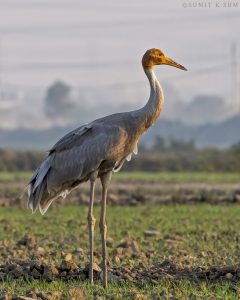
Watching Sarus parents guard and teach their young is one of the most touching sights in the wild.
Are Sarus Cranes Migratory or Resident
Sarus Cranes are largely resident in India, although they may move locally depending on water availability. Unlike other crane species, they don’t undertake long-distance migrations — a blessing for birdwatchers who wish to spot them year-round.
Conservation Status and Threats to Sarus Cranes
Despite being the state bird of Uttar Pradesh, Sarus Cranes are listed as Vulnerable by IUCN. Their population is declining due to:
- Wetland destruction and drainage
- Pollution of water bodies
- Electric wire collisions
- Pesticide poisoning in farmlands
- Nest disturbance by humans or livestock
Conservation efforts include:
- Community-based wetland protection
- Awareness programs for farmers
- Government-supported conservation reserves
Related Link: Indian Peafowl – The Pride of India
Sarus Cranes in Indian Culture and Folklore
In Indian folklore, Sarus Cranes are symbols of love, devotion, and heartbreak.
- Ancient texts mention their mourning rituals.
- The famous poet Valmiki is said to have been inspired to write the Ramayana after witnessing the grief of a Sarus Crane whose mate was killed by a hunter.
- In many villages, people revere and protect Sarus pairs, considering them lucky or divine.
Tips for Spotting Sarus Cranes
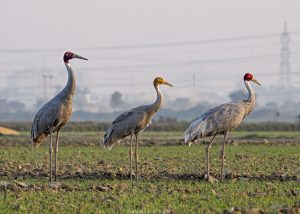
- Visit wetlands and paddy fields during the monsoon or post-monsoon.
- Best sightings: Sultanpur National Park, Bharatpur, Etawah Wetlands, Khajuraho
- Maintain distance and silence — they’re shy birds despite their size.
- Watch for dancing pairs early in the morning or just before sunset.
Related link: Spotted Owlet – The Little Guardian of the Indian Night
Sarus Cranes are more than just tall birds with a loud call. They’re guardians of wetlands, emblems of devotion, and a living thread in India’s cultural fabric. As urbanization threatens their homes, it’s more important than ever to protect their habitats and celebrate their presence in our ecosystems.
Next time you hear a long, echoing call from a wetland at dusk — look up. A pair of Sarus Cranes might just be dancing under the fading sun.
Also Read about These Birds
| White-throated Kingfisher | Purple Sunbird |
| Indian Pitta | Brown-headed Barbet |
| Common Kingfisher | Indian Paradise Flycatcher |
| Get your favourite Sarus Crane photograph framed for your wall – Request Now @+91-9540178459 |
